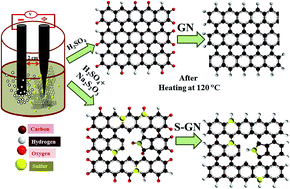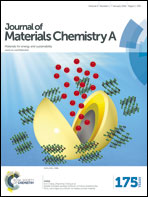Simultaneous sulfur doping and exfoliation of graphene from graphite using an electrochemical method for supercapacitor electrode materials†
Abstract
Doping with heteroatoms has become a significant strategy for modifying the electronic properties and enhancing the electrochemical properties of graphene (GN). In this study, an environmental friendly, economical and facile one pot electrochemical method was developed to synthesize sulfur-doped graphene (S-GN). Sodium thiosulphate (Na2S2O3), in addition to acting as a sulfur source, also catalyzed the exfoliation process, resulting in sulfur-doped GN structures. The exfoliation of graphite to GN and sulfur (S) doping occurred simultaneously resulting in well dispersed S-GN frameworks. Transmission electron microscopy and high-resolution transmission electron microscopy revealed the presence of the heteroatom in S-GN, and X-ray photoelectron spectroscopy confirmed the high S content (3.47%), as well as the existence of high-quality sulphureted species (mainly as C–S–C–). The incorporation of S species in GN during the exfoliation process modified the surface chemistry of carbon in the GN. The electrochemical performance of the as-prepared S-GN electrode exhibited a high specific capacitance of 320 F g−1 at a current density of 3 A g−1 and excellent cycling stability up to 1500 cycles as well as high energy density of 160 W h kg−1 at a power density of 5161 W kg−1 in an aqueous electrolyte.


 Please wait while we load your content...
Please wait while we load your content...